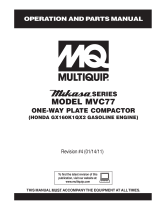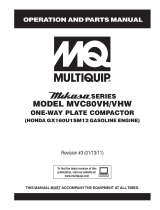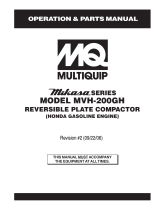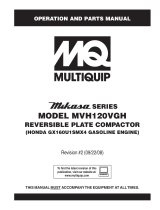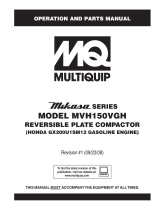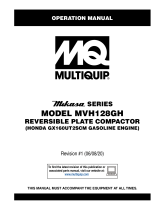Page is loading ...

OperatiOn and parts Manual
THIS MANUAL MUST ACCOMPANY THE EQUIPMENT AT ALL TIMES.
To find the latest revision of this
publication, visit our website at:
www.multiquip.com
SERIES
MODEL MVC88VTH
MODEL MVC88VTHW
ONE-WAY PLATE COMPACTOR
(HONDA GX160UT2QMX2 GASOLINE ENGINE)
Revision #2 (12/09/13)

PROPOSITION 65 WARNING

NOTES

TABLE OF CONTENTS
MVC88VTH/MVC88VTHW
Forward Plate Compactor
Proposition 65 Warning ........................................... 2
Table Of Contents .................................................... 4
Parts Ordering Procedures ...................................... 5
Safety Information .............................................. 6-10
Specifications ........................................................ 11
Dimensions ............................................................ 12
General Information ............................................... 13
Compactor Components ........................................ 14
Compactor Components ........................................ 15
Inspection .............................................................. 16
Inspection .............................................................. 17
Startup .............................................................. 18-19
Operation ............................................................... 20
Operation/Maintenance ......................................... 21
Maintenance ..................................................... 22-25
Explanation Of Code In Remarks Column............. 26
Suggested Spare Parts ......................................... 27
Compactor Component Drawings
Body Assembly ................................................. 28-31
Vibrator Assembly ............................................ 32-33
Transport Wheel Assembly ............................... 34-35
Sprinkler Assembly ........................................... 36-37
Urethane Plate Assembly ................................. 38-39
Nameplate and Decals ..................................... 40-41
Honda GX160UTQMX2 Engine
Component Drawings
Cylinder Head Assembly .................................. 42-43
Cylinder Barrel Assembly ................................. 44-45
Crankcase Cover Assembly ............................. 46-47
Crankshaft Assembly ........................................ 48-49
Piston Assembly ............................................... 50-51
Camshaft Assembly .......................................... 52-53
Recoil Starter Assembly ................................... 54-55
Fan Cover Assembly......................................... 56-57
Carburetor Assembly ........................................ 58-59
Air Cleaner Assembly ....................................... 60-61
Muffler Assembly .............................................. 62-63
Fuel Tank Assembly .......................................... 64-65
Flywheel Assembly ........................................... 66-67
Ignition Coil Assembly ...................................... 68-69
Control Assembly ............................................. 70-71
Decals ............................................................... 72-73
Terms and Conditions of Sale — Parts ................. 74
NOTICE
Specifications and part numbers are subject to change
without notice.

PARTS ORDERING PROCEDURES
www.multiquip.com
Ordering parts has never been easier!
Choose from three easy options:
When ordering parts, please supply:
❒
❒
❒
❒
❒
❒
❒
✓ UPS/Fed Ex ✓ DHL
■ Priority One ✓ Tr uc k
■ Ground
■ Next Day
■ Second/Third Day
If you have an MQ Account, to obtain a Username
and Password, E-mail us at:
To obtain an MQ Account, contact your
District Sales Manager for more information.
Order parts on-line using Multiquip’s SmartEquip website!
■ View Parts Diagrams
■ Order Parts
■ Print Specifi cation Information
Note: Discounts Are Subject To Change
Goto www.multiquip.com and click on
Order Parts
to log in and save!
Use the internet and qualify for a
on Standard orders for all orders which include
complete part numbers.*
All customers are welcome to order parts via Fax.
1-800-6-PARTS-7 (800-672-7877)
Fax your order in and qualify for a
on Standard orders for all orders which include
complete part numbers.*
1-800-427-1244
International Customers should contact
their local Multiquip Representatives for
Parts Ordering information.
Contact your local Multiquip Dealer for
parts or call 800-427-1244 for help in
locating a dealer near you.
Note: Discounts Are Subject To Change
Effective:
January 1
st
, 2006
NOTICE
All orders are treated as Standard Orders and will
ship the same day if received prior to 3PM PST.

SAFETY INFORMATION
Do not operate or service the equipment before reading
the entire manual. Safety precautions should be followed
at all times when operating this equipment.
Failure to read and understand the safety
messages and operating instructions could
result in injury to yourself and others.
The four safety messages shown below will inform you
about potential hazards that could injure you or others. The
safety messages specifi cally address the level of exposure
to the operator and are preceded by one of four words:
or
Indicates a hazardous situation which, if not avoided,
result in or
Indicates a hazardous situation which, if not avoided,
result in or
Indicates a hazardous situation which, if not avoided,
result in or
NOTICE
Addresses practices not related to personal injury.
Potential hazards associated with the operation of this
equipment will be referenced with hazard symbols which
may appear throughout this manual in conjunction with
safety messages.

SAFETY INFORMATION
operate this equipment without proper protective
clothing, shatterproof glasses, respiratory protection,
hearing protection, steel-toed boots and other protective
devices required by the job or city and state regulations.
operate this equipment when not
feeling well due to fatigue, illness or when
under medication.
operate this equipment under the infl uence of
drugs or alcohol.
check the equipment for loosened threads or
bolts before starting.
use the equipment for any purpose other than
its intended purposes or applications.
clear the work area of any debris, tools, etc.
that would constitute a hazard while the equipment is
in operation.
NOTICE
This equipment should only be operated by trained and
qualifi ed personnel 18 years of age and older.
Whenever necessary, replace nameplate, operation and
safety decals when they become diffi cult read.
Manufacturer does not assume responsibility for any
accident due to equipment modifi cations. Unauthorized
equipment modifi cation will void all warranties.
use accessories or attachments that are not
recommended by Multiquip for this equipment. Damage
to the equipment and/or injury to user may result.
know the location of the nearest
know the location of the nearest
know the location of the nearest phone or
Also, know the phone numbers
of the nearest and
This information will be invaluable in the case of an
emergency.

SAFETY INFORMATION
operate the equipment in an explosive
atmosphere or near combustible materials. An
explosion or fi re could result causing severe
disconnect any
These devices are intended for operator safety.
Disconnection of these devices can cause severe injury,
bodily harm or even death. Disconnection of any of these
devices will void all warranties.
lubricate components or attempt service on a
running machine.
NOTICE
keep the machine in proper running condition.
Fix damage to machine and replace any broken parts
immediately.
store equipment properly when it is not being
used. Equipment should be stored in a clean, dry location
out of the reach of children and unauthorized personnel.
The engine fuel exhaust gases contain poisonous carbon
monoxide. This gas is colorless and odorless, and can
cause death if inhaled.
The engine of this equipment requires an adequate
free fl ow of cooling air. operate this equipment
in any enclosed or narrow
area where free fl ow of the
air is restricted. If the air
fl ow is restricted it will cause
injury to people and property
and serious damage to the
equipment or engine.
place hands or fingers inside engine
compartment when engine is running.
operate the engine with heat shields or
guards removed.
Keep fi ngers, hands hair and clothing away
from all moving parts to prevent injury.
touch the hot exhaust manifold,
muffl er or cylinder. Allow these parts to
cool before servicing equipment.
NOTICE
run engine without an air fi lter or with a dirty air
fi lter. Severe engine damage may occur. Service air fi lter
frequently to prevent engine malfunction.
tamper with the factory settings
of the engine or engine governor. Damage
to the engine or equipment can result
if operating in speed ranges above the
maximum allowable.
tip the engine to extreme angles during lifting as
it may cause oil to gravitate into the cylinder head, making
the engine start diffi cult.

SAFETY INFORMATION
add fuel to equipment if it is placed inside truck
bed with plastic liner. Possibility exists of explosion or
fi re due to static electricity.
start the engine near spilled fuel or combustible
fl uids. Diesel fuel is extremely fl ammable and its vapors
can cause an explosion if ignited.
refuel in a well-ventilated area, away from
sparks and open fl ames.
use extreme caution when working with
liquids.
fi ll the fuel tank while the engine is running
or hot.
overfi ll tank, since spilled fuel could ignite if it
comes into contact with hot engine parts or sparks from
the ignition system.
Store fuel in appropriate containers, in well-ventilated
areas and away from sparks and fl ames.
use fuel as a cleaning agent.
smoke around or near the
equipment. Fire or explosion could result
from fuel vapors or if fuel is spilled on a
hot engine.
FUEL
FUEL
drop the battery. There is a possibility that the
battery will explode.
expose the battery to open fl ames,
sparks, cigarettes, etc. The battery contains
combustible gases and liquids. If these
gases and liquids come into contact with a
fl ame or spark, an explosion could occur.
wear safety glasses when
handling the battery to avoid eye irritation.
The battery contains acids that can cause
injury to the eyes and skin.
Use well-insulated gloves when picking up
the battery.
keep the battery charged. If the battery is not
charged, combustible gas will build up.
charge battery if frozen. Battery can explode.
When frozen, warm the battery to at least 61°F (16°C).
recharge the battery in a well-ventilated
environment to avoid the risk of a dangerous concentration
of combustible gases.
If the battery liquid (dilute sulfuric acid)
comes into contact with ,
rinse skin or clothing immediately with
plenty of water.
If the battery liquid (dilute sulfuric acid) comes into
contact with
, rinse eyes immediately with plenty
of water and contact the nearest doctor or hospital to
seek medical attention.
disconnect the
before performing service on the equipment.
keep battery cables in good working condition.
Repair or replace all worn cables.

NEVER allow any person or animal to stand underneath
the equipment while lifting.
NOTICE
Before lifting, make sure that the equipment parts (hook
and vibration insulator) are not damaged and screws are
not loose or missing.
Always make sure crane or lifi tng device has been
properly secured to the lifting bail (hook) of the
equipment.
shutdown engine before transporting.
lift the equipment while the engine is running.
Tighten fuel tank cap securely and close fuel cock to
prevent fuel from spilling.
Use adequate lifting cable (wire or rope) of suffi cient
strength.
Use one point suspension hook and lift straight
upwards.
lift machine to unnecessary heights.
tie down equipment during transport by
securing the equipment with rope.
NOTICE
Decommissioning is a controlled process used to safely
retire a piece of equipment that is no longer serviceable.
If the equipment poses an unacceptable and unrepairable
safety risk due to wear or damage or is no longer cost
effective to maintain (beyond life-cycle reliability) and is to
be decommissioned (demolition and dismantlement),be
sure to follow rules below.
pour waste or oil directly onto the ground, down
a drain or into any water source.
Contact your country's Department of
Public Works or recycling agency in your
area and arrange for proper disposal of
any electrical components, waste or oil
associated with this equipment.
When the life cycle of this equipment is over, remove
battery and bring to appropriate facility for lead
reclamation. Use safety precautions when handling
batteries that contain sulfuric acid.
When the life cycle of this equipment is over, it is
recommended that the trowel frame and all other metal
parts be sent to a recycling center.
Metal recycling involves the collection of metal from
discarded products and its transformation into raw
materials to use in manufacturing a new product.
Recyclers and manufacturers alike promote the process
of recycling metal. Using a metal recycling center
promotes energy cost savings.
NOTICE
The gasoline engine used in this equipment has been
designed to reduce harmful levels of carbon monoxide
(CO), hydrocarbons (HC) and nitrogen oxides (NOx)
contained in gasoline exhaust emissions.
This engine has been certifi ed to meet US EPA Evaporative
emissions requirements in the installed confi guration.
Attempting to modify or make adjustments to the engine
emmission system by unauthorized personnel without
proper training could damage the equipment or create an
unsafe condition.
Additionally, modifying the fuel system may adversely affect
evaporative emissions, resulting in fi nes or other penalties.
The emission control label is an integral part of the emission
system and is strictly controlled by regulation(s).
The label must remain with the engine for its entire life.
If a replacement emission label is needed, please contact
your authorized engine distributor.
SAFETY INFORMATION

SPECIFICATIONS
Centrifugal Force 3,372 lbs. (1,530 kg)
Vibration Frequency 6,000 vpm (60 Hz)
Traveling Speed 82 ft/min (25 m/min)
Plate Size (L x W) 19.7 x 20.7 in (.500 x .525 mm)
Max. Area of Compaction (no extensions) 8,100 sq. ft./hr (752 sq. m/hr)
Operating Weight MVC88VTGH
Operating Weight MVC88VTHW
207 lbs. (95 kg.)
229 lbs. (104 kg.)
Water Tank Capacity 13.7 qt (13.0 liters)
Anti-Vibration Handle Ye s
Lubricating Oil in Vibration Case 6.7 fl. oz. (200 cc)
Engine Make HONDA
Engine Model GX160UT2QMX2
Engine Type
Air-cooled 4 stroke, Single Cylinder, OHV,
Horizontal Shaft Gasoline Engine
Cylinder Bore X Stroke 2.7 in. x 1.8 in. (68 mm x 45 mm)
Displacement 163 cc (9.9 cu-in)
Maximum Ouput 4.8 HP (3.6 kW) @ 3600 RPM
Fuel Tank Capacity Approx. .825 U.S. gallons (3.1 liters)
Fuel Type Unleaded 86 Octane or Higher
Oil Capacity .61 qts (0.58 liters)
Air Cleaner Dual Element
Starting Method Recoil Start
Dry Net Weight Recoil/Electric 33 lbs (15 Kg.)
Dimensions (L x W x H) 12.2 x 14.3 x 13.6 in (312 x 362 x 346 mm)

DIMENSIONS
A 24.5 (622)
B 22.5 (571)
C 43.5 (1,105)
D 36.0 (914)
E 19.7 (500)
Figure 1. Dimensions
A
B
D
EC

GENERAL INFORMATION
The Mikasa MVC88VTH/VTHW is a walk behind, plate
compactor designed for the compaction of sand, mixed soils
and asphalt. This plate compactor is a powerful compacting
tool capable of applying a tremendous force in consecutive
high frequency vibrations to a soil surface. Its applications
include compacting for road, embankments and reservoirs
as well as backfilling for gas pipelines, water pipelines and
cable installation work.
The vibratory plates of the compactor produce low
amplitude high frequency vibrations, designed to compact
granular soils and asphalt.
The resulting vibrations cause forward motion. The engine
and handle are vibration isolated from the vibrating plate.
The compactor's vibrating plate produces a vibration
frequency of 6,000 VPM (vibrations per minute). The
travel speed of the compactor is approximately 82 ft/
minute (25 meters/minute).
These plate compactors are equipped with a Honda
GX160UT2QMX2 air cooled, 4-cycle gasoline engine.
The engine drives an eccentric weight at a high speed to
develop a compaction force.
In addition this engine is equipped with an oil alert system
that will automatically stop the engine before the engine
falls below safe engine oil operating limits. Always be sure
to check the engine oil level prior to starting the engine.
Before starting the plate compactor identify and understand
the function of all the controls and components.

COMPACTOR COMPONENTS
Figure 2. Plate Compactor Components
1
MVC88VTHW
MVC88VTH
ON
OFF
2
3
4
5
6
7
8
9
10
11
Figure 2 shows the location of the basic controls and
components of the MVC88VTH/VTHW Plate Compactor.
The function of each control is described below:
1. – When operating the compactor use this
handle bar to manuever the compactor.
2. – When lifting of the compactor is required
either by forklift, crane etc., tie rope or chain around
this lifting point.
3. – Remove this cap to add fuel. Use
only unleaded fuel with an octane rating of 86 or higher
4. – Remove this cap to
add water to the water tank.
5. – Holds 13.7 quarts of water
(removable, no tools required).
6. – A flat, open plate made of durable
cast iron construction used in the compacting of soil.
7. – Supplies water
to the soil via a splash plate.
8. – Turn this valve
downward to let water flow from the water tank to the
water tube.
9. – These plate compactors use a Honda
GX160, 4.8 HP, air-cooled 4 stroke gasoline engine.
Refer to the Honda owner's manual for more detailed
engine information and related topics.
10. – Remove this cover to gain acess to the
V-belts.run the compactor without the V-belt
cover. If the V-belt cover is not installed, the possibility
exists that your hand may get caught between the V-belt
and clutch, causing serious injury and bodily harm.
11. – Encloses the eccentric, gears
and counter weights.

COMPACTOR COMPONENTS
Figure 3. Engine Controls and Components
1
2
3
4
5
6
7
8
9
10
11
12
The engine (Figure 3) must be checked for proper
lubrication and filled with fuel prior to operation. Refer to the
manufacturer's engine manual for instructions and details
of operation and servicing.
1. – Remove this cap to add unleaded
gasoline to the fuel tank. Make sure cap is tightened
securely. over fill.
2. – Used to adjust engine RPM speed.
For normal operation this lever should always be placed
in the position.
3. – Manual-starting method.
Pull the starter grip until resistance is felt, then pull
briskly and smoothly.
4. Fuel Valve Lever – to let fuel flow, to
stop the flow of fuel.
5. – Used in the starting of a cold engine,
or in cold weather conditions. The choke enriches the
fuel mixture.
Add fuel to the tank only when the engine
is stopped and has had an opportunity to
cool down. In the event of a fuel spill,
attempt to start the engine until the
fuel residue has been completely wiped up
and the area surrounding the engine is dry.
6. – Prevents dirt and other debris from
entering the fuel system. Remove wing-nut on top of
air filter canister to gain access to filter element.
7. – Provides spark to the ignition system.
Set spark plug gap according to engine manufacturer's
instructions. Clean spark plug once a week.
8. – Used to reduce noise and emissions.
touch when hot!
9. – Fill with unleaded gasoline. Reference
Table 2 for fuel tank capacity. For additional information
refer to Honda engine owner's manual.
10. – Remove this cap to determine
if the engine oil is low. Add oil through this filler port as
recommended in (Table 4).
11. – Remove this plug to remove oil from
the engine's crankcase.
12. – position permits engine
starting, position stops engine operation.
NOTICE
Operating the engine without an air filter, with a
damaged air filter, or a filter in need of replacement
will allow dirt to enter the engine, causing rapid engine
wear.

INSPECTION
1. Read all safety instructions at the beginning of manual.
2. Clean the compactor, removing dirt and dust,
particularly the engine cooling air inlet, carburetor and
air cleaner.
3. Check the air filter for dirt and dust. If air filter is dirty,
replace air filter with a new one as required.
4. Check carburetor for external dirt and dust. Clean with
dry compressed air.
5. Check fastening nuts and bolts for tightness.
1. To check the engine oil level, place the compactor on
secure level ground with the engine stopped.
2. Remove the dipstick from the engine oil filler hole
(Figure 4) and wipe clean.
Figure 4. Engine Oil Dipstick Removal
3. Insert and remove the dipstick without screwing it into
the filler neck. Check the oil level shown on the dipstick.
4. If the oil level is low (Figure 5), fill to the edge of the
oil filler hole with the recommended oil type as listed
in Table 4. Reference Table 2 for maximum engine oil
capacity.
Figure 5. Engine Oil Dipstick (Oil Level)
Summer 25°C or Higher SAE 10W-30
Spring/Fall 25°C~10°C SAE 10W-30/20
Winter 0°C or Lower SAE 10W-10
1. Visually inspect (Figure 6) to see if fuel level is low. If
fuel is low, replenish with unleaded fuel.
Figure 6. Fuel Check
2. When refueling, be sure to use a strainer for filtration.
top-off fuel. Wipe up any spilled fuel
immediately.
If your unit is equipped with a water tank (Figure 7) and
your applications requires water, fill water tank.
Figure 7. Water Tank Filling
Motor fuels are highly flammable and can
be dangerous if mishandled.
smoke while refueling. attempt
to refuel the compactor if the engine is
hot! or running.
FUEL
CAP
WATER
TANK
WATER
SOURCE

To inspect the V-belt, remove the three bolts that secure
the belt cover to the frame as shown in Figure 8.
Figure 8. V-Belt Cover Removal
Visually examine the V-belt (Figure 9) and determine if it
is full of tiny cracks, frayed, has pieces of rubber missing,
is peeling or otherwise damaged.
Also, examine the belt and determine if it is oil soaked or
"glazed " (hard shiny appearance on the sides of the belt).
Either of these two conditions can cause the belt to run hot,
which can weaken it and increase the danger of it breaking.
If the V-belt exhibits any of the referenced wear conditions
replace the V-belt immediately
Figure 9. Drive Belt Inspection
Mikasa
VIBRATOR
REMOVE
REMOVE
V-BELT COVER
V-BELT
GLAZED
OIL SOAKED
BROKEN
CORD FAILURE
CRACKS
MISSING RUBBER
SIDEWALL
WEAR
WORN BACK
COVER
INSPECTION
The V-belt tension is proper if the V-belt bends 10 to 15 mm
(Figure 10) when depressed with finger at midway between
the clutch and vibrator pulleys.
Figure 10. V-Belt Tension
1. Place the plate compactor horizontally on a flat surface.
Make sure the compactor is level when checking the
oil in the vibrator assembly.
2. Check vibrator oil level by removing the oil plug (vibrator
oil gauge) as shown in Figure 11. The oil level should
be up to the oil plug.
3. The vibrator holds approximately 6.7 oz. (200 cc).
, if oil is required, replace using only SAE
10W-30 motor oil.
Figure 11. Vibrator Oil Check
CORRECT V-BELT
TENSION 10-15 MM
WHEN DEPRESSED
AS SHOWN.
V-BELT
CLUTCH
PULLEY
VIBRATOR
PULLEY
VIBRATOR
OIL PLUG
PACKING

This section is intended to assist the operator with the
initial start-up of the compactor. It is extremely important
that this section be read carefully before attempting to use
the compactor in the field.
1. Place the engine fuel valve lever (Figure 12) to the
“” position.
Figure 12. Engine Fuel Valve Lever (ON Position)
2. Move the throttle lever (Figure 13) away from the idle
position, about 1/3 of the way toward the run position.
Figure 13. Throttle Lever (1/3 Start Position)
attempt to operate the compactor
until the Safety, General Information and
Inspection sections of this manual have
been read and thoroughly understood.
STARTUP
3. Place the choke lever (Figure 14) in the
position if starting a cold engine.
Figure 14. Choke Lever (Closed)
4. Place the engine ON/OFF switch (Figure 15) in the
"" position.
Figure 15. Engine ON/OFF Switch (ON Position)
5. Grasp the starter grip (Figure 16) and slowly pull it
out. The resistance becomes the hardest at a certain
position, corresponding the compression point. Rewind
the rope a little from that point and pull out sharply.
CLOSED
CHOKE LEVER
NOTICE
The position of the choke lever enriches the
fuel mixture for starting a engine. The
position provides the correct fuel mixture for normal
operation after starting, and for restarting a warm
engine.

STARTUP
Figure 16. Starter Grip
6. When engine starts, release the starter grip and allow
the rope to recoil.
7. If the choke lever was moved to the " position
to start the engine gradually move it to the
position (Figure 17) as the engine warms up. If the
engine has not started repeat steps 1 through 6.
Figure 17. Choke Lever (Open)
8. Before the compactor is placed in to operation, run the
engine for several minutes. Check for fuel leaks, and
noises that would associate with a lose component.
NOTICE
pull the starter rope all the way to the end
release the starter rope after pulling. Allow it
to rewind as soon as possible.
CHOKE
LEVER
OPEN
9. If the sprinkling of water is required, place water valve
in the position.
Figure 18. Water Valve (ON)
10. To begin compacting, place the throttle lever (Figure 19)
in the “” position
.
Figure 19. Throttle Lever (Run)
ON
OFF

OPERATION
1. Once the engine has started, move the engine throttle
lever quickly to the run position.
2. With the throttle lever in the run position, the engine
speed should be around 2,300 RPM, therefore
engaging the centrifugal clutch.
3. Firmly gasp the compactor's handle bar with both
hands, the compactor will begin moving forward.
4. Slowly walk behind the compactor and be on the
lookout for any large objects or foreign matter that
might cause damage to the compactor or bodily injury.
5. Compactor traveling speed may drop on soils which
contain clay, however there may be cases where
traveling speed drops because the compaction plate
does not leave the ground surface easily due to the
composition of the soil. To rectify this problem do the
following:
Check the bottom plate to see if clay or equivalent
material has been lodge in the plate mechanism. If so,
wash with water and remove.
Remember the compactor does not work as efficiently
on clay or soils that have a high moisture content level.
If the soil has a high moisture level, dry soil to appropriate
moisture content level or carry out compaction twice.
follow all safety rules referenced
in the safety section of this manual before
operating compactor. Keep work area
clear of debris and other objects that
could cause damage to the compactor or
bodily injury.
NOTICE
move the throttle lever quickly without
hesitation, because increasing the engine speed slowly
causes the clutch to slip.
NOTICE
stop the engine suddenly while working at
high speeds.
1. Move the throttle lever to the idle position (Figure 20)
and run the engine for three minutes at low speed.
Figure 20. Throttle Lever (Idle)
2. Place the engine ON/OFF switch (Figure 21) in the
"" position.
Figure 21. Engine ON/OFF Switch (OFF Position)
3. Place the fuel shut-off lever (Figure 22) in the "
position.
Figure 22. Fuel Valve Lever (OFF)
4. If applicable place water valve (Figure 18) in the
position.
1. Move the throttle lever quickly to the position, and
place the engine ON/OFF switch in the position.
ENGINE SWITCH
ON
OFF
/

